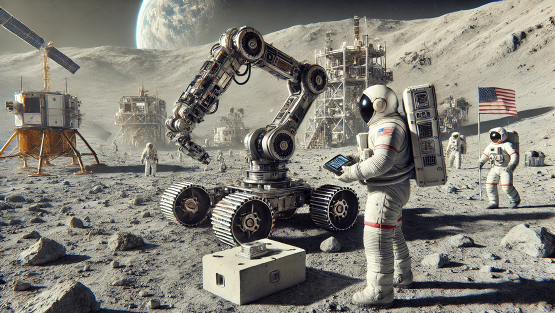Information - FW-HRC
Future Workforce in Human-Robot Collaboration
Main menu:
Expert Meeting
Roadmap to Future-Ready Extraterrestrial Construction Workforce Development:
Technological Visions and Needs
The goal of the expert meeting is:
- To develop a better understanding of the definition, hierarchy, and categorization of workforce skills in the context of future extraterrestrial construction with a focus on human-robot collaboration tasks.
- To explore training environments enabled by adopting emerging technologies to make the existing workers become ready for the future frontier.
We bring together expertise in engineering, construction science, architecture, computer science, robotics, human-computer interaction, planetary geoscience, workforce development, and learning sciences to achieve our research goals. We have participants from a wide range of universities and industry partners, including University of Michigan, Jacobs, University of Notre Dame, Texas A&M University, University of Florida, Georgia Tech University, San Diego State University, Arizona State University, Yale University, Cornell University, NASA Jet Propulsion Laboratory, Purdue University, Oklahoma State University, Simmons University, Drake State University. Our industry collaborators include ICON build (Space Architecture), SEArch+ (Space Architecture), Proximal LLC (immersive education startup), Honeybee Robotics, Trimble’s Field Technologies Group, NASA Jet Propulsion Laboratory (JPL) group, Jacobs Space Exploration Group (JSEG), among others.
We plan a two-day interdisciplinary expert meeting (February 20-21, 2023), which is held virtually to cope with the COVID-19 pandemic and provide accessible participation nationwide. The goal of this expert meeting is to converge on the nature of future extraterrestrial construction and build the hierarchy of skills required by future workers, as well as emerging technologies that can be utilized to integrate transferable skills for developing a future-ready workforce from a diverse set of perspectives.
The expert meeting is organized under three main themes:
Theme 1: Future Work (Extraterrestrial Construction)
- How does the construction site environment on the Moon and Mars differ from Earth?
- What are the main characteristics of construction technologies used in extraterrestrial construction on the Moon and Mars?
- Is there any robot function in extraterrestrial construction that can’t/shouldn’t be fully automated?
Theme 2: Future Workers (Extraterrestrial Construction Workforce)
- What are the main anthropic tasks, roles, knowledge, and competencies/skills needed by the future civil workforce in extraterrestrial construction?
- To collaborate with robots effectively, what skills/knowledge are required for the future workforce?
- How can the identified skills be framed, categorized, or prioritized?
Theme 3: Future Technology (Emerging Technologies for Workforce Training)
- What are the strategies and considerations in developing training scenarios in an AI-XR-based training environment for future workforce development?
- Among the skills and competencies identified for the extraterrestrial construction workforce, which ones are more suitable to be trained using an AI-XR-based training environment?
- How can the trained skills and competencies using an AI-XR-based training environment be evaluated in the context of extraterrestrial construction?
We structure the meeting as a series of charrettes in which small and diverse groups brainstorm and design answers to questions associated with each theme. The expert meeting activities include invited plenary talks, panel discussions, and breakout sessions on the three main themes. Instructions for the moderators of these sessions are prepared to facilitate discussion and data collection.

